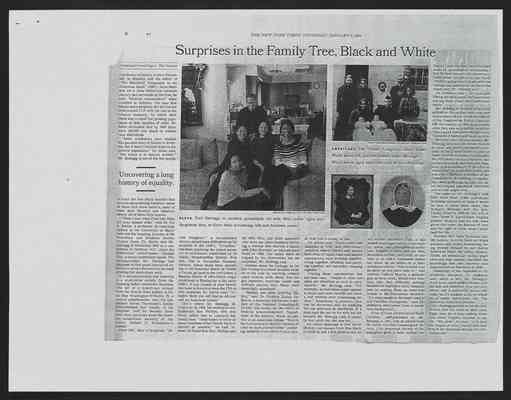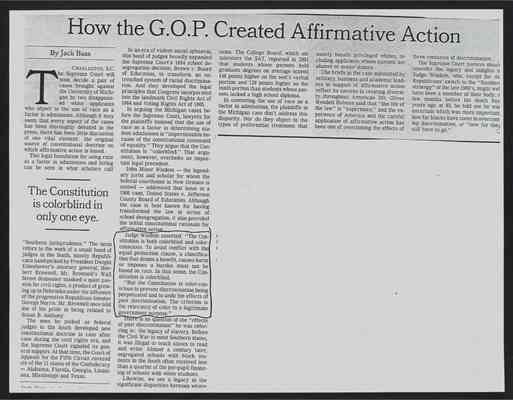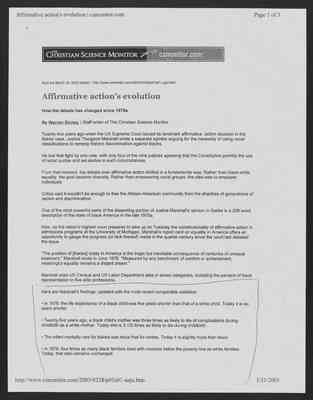Pages
1
Surprises in the Family Tree _______________________________________ By MITCHEL OWENS _______________________________________
JOHN ARCHER first appears in Northampton County, Va., in the mid-17th century. He started a family that prospered, fought in the Revolutionary War and built a mansion. Generations later, Archer's blood trickled down to me. It mingled in my veins with DNA from a gravedigger in 17th-century Württemberg, Germany; from an Appalachian clan with a recessive gene that turns their skins indigo blue; and from a rich young widow in Jamestown, Va., whose fickle heart led to America's first breach-of-promise suit, in 1623.
I have been researching my past for two decades, since I was in high school, so finding a new ancestor is hardly startling. Learning about John Archer three years ago, however, was startling. He was black, a slave or indentured servant freed around 1677. I am white. That's what it says on my birth certificate. Now I know better, thanks to Paul Heinegg.
A retired oil-refinery engineer in Collegeville, Pa., Mr. Heinegg, who is white, has compliled genealogies of 900 mixed-race families who lived freely in slaveholding states in "Free African Americans of North Carolina, South Carolina and Virginia" and "Free African Americans of Maryland and Delaware." (The information posed on a Web site, www.freeafricanamericans.com.)
Mr. Heinegg's research offers evidence that most free African-American and biracial families resulted not from a master and his slave, like Thomas Jefferson and Sally Hemings, but from a white woman and an African man: slave, freed slave or indentured servent.
"Most of the workers in colonial America in the 17th and early 18th centures were indentured servants, white and black," said Dr John B. Boles,
Continued on Page 4
2
THE NEW YORK TIMES, THURSDAY, JANUARY 8, 2004
Surprises in the Family Tree, Black and White
[image:] Paul Heinegg and his family. Attributed to Salvatore D. DiMarco Jr. for The New York Times. With the following text:
BLEND Paul Heinegg, an amateur genealogist, his wife, Rita, center right, and daughters: Ayo, on floor; Asha Armstrong, left; and Andiswa, center.
[image:] Langston family. Attributed to Smithsonian. With the following text:
AMERICANS The "Indian Langstons, above; Susan Ward, below left, and her mother, Susan Mozingo Ward, below right, born 1809, part African-American.
[image:] Photograph of Susan Ward. Attributed to Melicent Remy.
[image:] Photograph of Susan Mozingo Ward. Attributed to Melicent Remy.
Continued From Page 1, This Section
a professor of history at Rice University in Houston and the editor of "The Blackwell Companion to the American South" (2001). Since there was not a clear distinction between slavery and servitude at the time, he said, "biracial camaraderie" often resulted in children. The idea that blacks were property did not harden until around 1715 with the rise of the tobacco economy, by which time there was a small but growing population of free families of color. Dr. Boles estimated that by 1860 there were 250,000 free black or mixed-raced individuals.
"Some academics have studied this parallel story of blacks in America, but it hasn't trickled down to the general population," Dr. Boles said. "The action is in slavery studies." Mr. Heinegg is one of the few people
[sidebar:] Uncovering a long history of equality.
to trace the free black families that lived in slave-owning America: some of them rich slave owners, most of them poor farmers and laborers, nearly all of them little known.
"When I saw what Paul had done, my eyes opened wide," said Dr. Ira B. Berlin, a professor of American history at the University of Maryland and the founding director of the Freedmen and SOuthern Society Project there. Dr. Berlin met Mr. Heinegg in November 2000 at a conference in Durham, N.C., about the mixed-race cabinetmaker Thomas Day, a major antebellum figure. The documentation Mr. Heinegg had amassed in five years convinced Dr. Berlin to write a foreword to his book praising his meticulous work.
It is incontrovertible that America is a multiracial society, from the founding father Alexander Hamilton (the son of a mixed-race woman from the British West Indies) to Essie Mae Washington-Williams, 78, a retired schoolteacher, who, the late Senator STrom Thurmond's family acknowledge last month, is his daughter. And for decades there have been questions about the possible mixed-race ancestry of Ida Stover, Dwight D. Eisenhower's mother.
Since 1997, after it broadcast "Secret Daughter," a documentary about a mixed-race child given up for adoption in the 1950's, "Frontline" has been exploring the mixed ancestry of well-known Americans on its Public Broadcasting System Web site. One is AJacqueline Kennedy Onassis, whose blood lines, according to the historian Mario de Valdes y Cocom, go back to the van Salees, a Muslim family of Afro-Dutch origin prominent in Manhattan in the early 1600's. If any branch of your family has been in America since the 17th or 18th centuries, Dr. Berlin said, "It's highly likely you will find an African and an American Indian."
That's where Mr. Heinegg, 60, comes in. In 1985, his mother-in-law, Katherine Kee Phillips, who was black, asked him to research her family tree. "I had hoped to trace as many branches of her family back to slavery as possible," he said. Instead, he found that Mrs. Phillips and his wife, Rita, had white ancestors who were not slave masters, including a woman who started a family with John Kecatan, an African slave freed in 1666. The ladies were intrigued by his discoveries but not surprised, Mr. Heinegg said.
Curious about his findings, he began tracing free black families related to his wife by combing colonial court records, wills, deeds, free Negro registers, marriage bonds and military pension files. Many were dauntingly unindexed.
"Nobody has done anything like this," said Dr. Virginia Easley De-Marce, a historian and former president of the National Genealogical Society who works for teh Office of Federal Acknowledgment, Department of the Interio, which decides who is an American Indian. "Paul is the first person to identify families of color on such a broad scope," gathering material from entire states rather than just a county or two.
Dr. Berlin said, "There were communities in 17th- and 18th-century America where blacks and whites, both free, of equal rank and shared experiences, were working together, living together, drinking and partying together, and inevitably sleeping together."
Tracing those communities has not been easy. "People of color are often not identified as such in early records," Mr. Heinegg said. "For example, an individual might appear in deeds and court records and leave a will without ever mentioning his race." Sometimes a person's race can be discerned only by studying the tax assess on nonwhites. If a man paid the tax on his wife but not himself, Mr. Heinegg said, it meant that he was white but she was not.
An added challenge is that racial identity can mutate from free black to white in just a few generations. In my Archer ancestors' case, it was mixed marriages and a cross-country move: my great-great-grandfather Esquire Collins and his wife, Roxalana Archer, are listed as mulatto in an 1800's Tennessee census but show up as white on a later Arkansas census. "You crossed over as early as you were able to," said Antonia Cottrell Martin, a genealogist in New York. Mixed-race families who had difficulty passing sometimes explained dark complexions as coming from an American Indian or Mediterranean ancestry. "It's what people in the South used to call Carolina Portuguese," said Dr. DeMarce, who comes from a mixed-race background.
"Free African Americans of North Carolina," self-published by Mr. Heinegg in 1991, won an award from the North Carolina Genealogical Society. (The American Society of Genealogist gave a later edition the Donald Lines Jacobus Award for best work of genealogical scholarship.) But the book also stirred controversy. Some white members of the North Carolina group were upset with his findings and asked that the award be withdrawn, Mr. Heinegg said.
Dr. DeMarce said: "He's just publishing the documents. He's not interpeting them. That's up to anthropologists."
Mr. Heinegg is familiar with racial prejudice. He and his wife, who met as members of the Brooklyn outpost of the Congress on Racial Equality, left the country in 1969, disgusted by what they saw as a lack of progress. They raised their three daughters in Tanzania, Liberia and Saudi Arabia.
But even when he was abroad, Mr. Heinegg ordered microfilm records by mail and spent one-month vacations in the United States to peer at faded records in county courthouses. He still works on his research, and updates his book and Web site regularly. A new edition of "Free African Americans" is published every two years by Clearfield, a division of the Genealogical Publishing Company, Inc., www.genealogical.com. The latest two-volume paperback costs $100 and is 1,042 pages long.
The index to Mr. Heinegg's book lists more than 12,000 individuals, including ancestors of mine it would be nice to know more about, like Richard Nickens and his wife, Chriss, freed in 1690 by the will of John Carter II, a prominent Virginia planter. Nickens and his wife were given two cows, six barrels of corn and the right to farm some Carter land for life.
Matters like these fascinate me. My brother, Derrick, finds our black ancestry only mildly interesting, being riveted instead by our Native American blood. My eldest nephew, Justin, an elementary school pupil obsessed with islands, cherishes the knowledge that one ancestors was shipwrecked on Bermuda in 1609.
Genealogy is not regarded as an academic discipline, Dr. DeMarce said, which is why Mr. Heinegg's work is not more widely know. And his lists are published by a specialty house, not a university press, she said, "so it's unlikely to be reviewed by a major publication like The American Historical Review."
Mr. Heinegg prefers to let the academics find his work on their own. Right now, he is busy adding more free black Virginia families to his list. "My goal," he said, "is to find the origins of every family that was free in the Southeast during the colonial period."
3
How the G.O.P. Created Affirmative Action -------------------------------------------------------------------------------------------------------------------------------- By Jack Bass -------------------------------------------------------------------------------------------------------------------------------- The Supreme Court will soon decide a pair of cases brought against the University of Michigan by two disappointed white applicants who object to the use of race as a factor in admissions. Although it may seem that every aspect of the cases has been thoroughly debated in the press, there has been little discussion of one vital element: the original source of constitutional doctrine on which affirmative action is based.
This legal foundation for using race as a factor in admissions and hiring can be seen in what scholars call -------------------------------------------------------------------------------------------------------------------------------- The Constitution is colorblind in only one eye. -------------------------------------------------------------------------------------------------------------------------------- "Southern jurisprudence." The term refers to the work of a small band of judges in the South, mostly Republicans hand-picked by President Dwight Eisenhowers attorney general, Herbert Brownell. Mr. Brownell's Wall Street demeanor masked a quiet passion for civil rights, a product of growing up in Nebraska under the influence of the progressive Republican Senator George Norris. Mr. Brownell once told me of his pride in being related to Susan B. Anthony.
The men he picked as federal judges in the South developed new constitutional doctrine in case after case during the civil rights era, and the Supreme Court signaled its general support. At that time, the Court of Appeals for the Fifth Circuit covered six of the 11 states of the Confederacy -- Alabama, Florida, Georgia, Louisiana, Mississippi, and Texas.
In an era of violent social upheaval, this band of judges broadly expanded the Supreme Court's 1954 school desegregation decision, Brown v. Board of Education, to transform an entrenched system of racial discrimination. And they developed the legal principles that Congress incorporated into the landmark Civils Rights Act of 1964 and Voting Rights Act of 1965.
In arguing the Michigan cases before the supreme Court, lawyers for the plaintiffs insisted that the use of race as a factor in determining student admissions is "impermissible because of the constitutional command of equality." They argue that the Constitution is "colorblind." That argument, however, overlooks an important legal precedent.
John Minor Wisdom -- the legendary jurist and scholar for whom the federal courthouse in New Orleans is named -- addressed that issue in a 1966 case, United States v. Jefferson County Board of Education. Although the case is best known for having transformed the law in terms of school desegregation, it also provided the initial constitutional rationale for affirmative action.
Next two paragraphs are circled in black ink
Judge Wisdom asserted: "The Constitution is both colorblind and color-conscious. To avoid conflict with the equal protection clause, a classification that denies a benefit, causes harm or imposes a burden must not be based on race. In that sense, the Constitution is colorblind.
"But the Constitution is color-conscious to prevent discrimination being perpetuated and to undo the effects of past discrimination. The criterion is the relevancy of color to a legitimate government purpose."
There is no question of the "effects of past discrimination" he was referring to: the legacy of slavery. Before the Civil War in most Southern states, it was illegal to teach [cuts off] sions. The College Board, which administers the SAT, reported in 2001 that students whos parents held graduate degrees on average scored 148 points higher on the test's verbal portion and 129 points higher on the math portion than students whose parents lacked a high school dipoloma. In contesting the use of race as a factor in admissions, the plaintiffs inthe Michigan case don't address this disparity. Nor do they object to the types of preferential treatment that mostly benefit privileged whites, including applicants whose parents are alumni or major donors. The briefs in the case submitted by military, business and academic leaders in support of affirmative action reflect its success in creating diversity throughout American life. Oliver Wendell Holmes said that "the life of the law" is "experience," and the experience of America and the careful application of affirmative action has been one of overcoming the effects of three centuries of discrimination.
The Supreme Court justices should consider the legacy and insights o[cuts off] Judge Wisdom, who, except for th[cuts off] Republicans' switch to the "Southern strategy" of the late 1960's, might wel[cuts off] have been a member of their body. A few months before before his death fou[cuts off] years ago at 93, he told me he was uncertain which was more important how far blacks have in overcoming discrimination, or "how far they still have to go." --------------------------------------------------------------------------------------------------------------------------------
4
| Affirmative action's evolution | csmonitor.com Page 1 of 3 |
|---|
from the March 28, 2003 edition - http://www.csmonitor.com/2003/0328/p01s01-usju.html
Affirmative action's evolution
How the debate has changed since 1970's.
| By Warren Richey | Staff writer of The Christian Science Monitor |
|---|
He lost that fight by one vote, with only four of the nine justices agreeing that the Constitution permits the use of racial quotas and set-asides in such circumstances.
From that moment, the debate over affirmative-action shifted in a fundamental way. Rather than black-white equality, the goal became diversity. Rather than empowering racial groups, the idea was to empower individuals.
Critics said it wouldn't be enough to free the African-American community from the shackles of generations of racism and discrimination.
One of the most powerful parts of the dissenting portion of Justice Marshall's opinion in Bakke is a 206-word description of the state of black America in the late 1970s.
Now, as the nation's highest court prepares to take up Tuesday the constitutionality of affirmative action in admissions programs at the University of Michigan, Marshall's report card on equality in America offers an opportunity to gauge the progress (or lack thereof) made in the quarter century since the court last debated the issue.
"The position of [blacks] today in America is the tragic but inevitable consequence of centuries of unequal treatment," Marshall wrote in June 1978. "Measured by any benchmark of comfort or achievement, meaningful equality remains a distant dream."
Marshall cited US Census and US Labor Department data in seven categories, including the percent of black representation in five elite professions.
[the rest of page circled in blue ink]
Here are Marshall's findings, updated with the most recent comparable statistics:
• In 1978, the life expectancy of a black child was five years shorter than that of a white child. Today it is six years shorter.
• Twenty-five years ago, a black child's mother was three times as likely to die of complications during childbirth as a white mother. Today she is 3-1/2 times as likely to die during childbirth.
• The infant mortality rates for blacks was twice that for whites. Today it is slightly more than twice.
• In 1978, four times as many black families lived with incomes below the poverty line as white families. Today, that ratio remains unchanged.
5
Affirmative action's evolution │ csmonitor.com Page 2 of 3
[• For black adults, the unemployment rate was twice that of whites, and for black teens it was three times. Today, both statistics remain unchanged.
• The median income of a black family in 1978 was 60 percent of the median of a white family. Today, it is 66 percent of white-family income.
• In 1978, blacks represented 11.5 percent of the population, but they were only 1.2 percent of the lawyers and judges, 2 percent of the physicians, 2.3 percent of the dentists, 1.1 percent of the engineers, and 2.6 percent of college and university professors. Today blacks represent 12.3 percent of the population, and are 5.1 percent of the lawyers and judges, 5.6 percent of physicians, 4.1 percent of dentists, 5.5 percent of engineers, and 6.1 percent of college and university professors.]
Conclusions from the numbers
Some analysts point to such statistics as proof that while a post-Bakke scaled-down version of affirmative action has helped bolster the ranks of black professionals, African-Americans as a whole have been left behind.
"Despite all the talk of the creation of a black middle class, the relative position of the black community to white America has not changed much," says Andrew Hacker, a Queens College political-science professor and author of "Two Nations: Black and White, Separate, Hostile, Unequal."
While such statistics might have provided compelling evidence for the justices debating affirmative action in the 1970s, since the Bakke decision black-white equality is no longer the intellectual underpinning that drives the affirmative action debate.
"I don't think anyone would disagree with Justice Marshall that there was a long history of tragic discrimination in the US, and as a result the socioeconomic status of African-Americans remains lower than other racial and ethnic groups," says Roger Clegg of the Center for Equal Opportunity, a conservative public-interest law group in Sterling, Va. "But a majority of the court [in Bakke] did not think that justified discrimination in favor of African-Americans."
To some analysts, the Bakke decision was more than a turning point; it was a U-turn.
"After Bakke, the debate shifted. There was no longer any talk of creating a racially just society," says john a. powell (who does not capitalize his name), a law professor at Ohio State University and executive director of the Kirwan Institute for the Study of Race and Ethnicity in the Americas.
"It is clear we are going backwards," he says. "High schools across the country are resegregating, and the court is saying this is not a constitutional injury. They are raising this huge barrier for people of color."
What`s permissible
Because affirmative-action plans take race into account, those using a race-based plan must show two things to avoid violating constitutional safeguards. First, they must show there is an important, persuasive reason to use race as a factor in a selection process. Second, they must show there is no way to achieve the same goal without using race as a factor.
To Marshall, the compelling government interest was to reverse and remedy the effects of discrimination that had long excluded most blacks from full participation in mainstream American life.
But because this viewpoint could not attract a fifth vote - that of Justice Lewis Powell - that rationale died in 1978. It was replaced with the concept of diversity.
Rather than seeking to remedy past discrimination, Justice Powell wrote in Bakke's majority opinion that the goal of achieving a diverse college student body was a compelling enough reason to justify consideration of race as a factor in college admissions. But he added that race could not be the primary, detrminate factor in the selection process.
http://www.csmonitor.com/2003/0328/p01s01-usju.htm 3/31/2003




